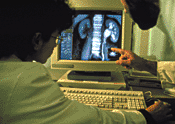Medical Imaging Reveals Storage Opportunity
"The market is growing big," said Dan Carson, vice president of marketing and business development at Open Systems Solutions, a Yardley, Pa.-based solution provider specializing in storage. "More and more radiological offices are opening across the country."
Radiology, which includes such procedures as PET scans, CAT scans and X-rays, generates Gbyte-size and Tbyte-size images, said Randy Kerns, senior partner of the Evaluator Group, a Greenwood Village, Colo.-based solution provider. While storing such images digitally would be a big boon to many in the medical field, the majority are still stored as film or other hard copy, making this a wide-open market for integrators to address with storage solutions, he said.

\
Most images are still stored as hard copy, making this a wide-open market for integrators.
"An MRI done for my knee recently had over 400 images," Kerns said. "That is a huge amount of data. It was stored in a packet. I had to pick the images up and hand-carry them to my doctor. They should have been stored as data. You can see why everybody is excited about this."
Hunt Russell, sales manager at Evolving Solutions, a Hamel, Minn.-based solution provider, said the storage market is growing fast in the health-care space.
Russell, one of Evolving Solutions' medical industry specialists, said one key driver is the need to help customers meet Health Insurance Portability and Accountability Act (HIPAA) regulations for secure, long-term storage of patients' private information. One of Evolving Solutions' clients is a physician-owned imaging center with 25 offices that is in the process of storing locally generated images at the branch locations, with the data copied to a central office for backup and archival purposes, he said.
"Medical companies are seeing they can't keep separate servers with separate storage," he said. "We can develop a three-year total- cost-of-ownership plan to show how to centralize their servers and storage."
John Murphy, executive vice president of Advanced Systems Group, a Denver-based solution provider, said his company is successfully selling into the medical imaging space and sees strong potential. "But nobody wants any liability in that space," he said. "I think storage suppliers are very cautious [there."
At the Radiological Society of North America 2002 Conference in Chicago early this month, IBM introduced four storage bundles for medical imaging.
The bundles include either a NAS subsystem or a FAStT array for online storage, an LTO-based tape library for near-line storage, and Tivoli Storage Manager software. Their capabilities and prices range from a bundle that can manage up to 25,000 studies per year with a starting price of $150,000 to a solution that can manage more than 250,000 studies per year with prices starting at about $1 million.
A few trends have prompted IBM to invest more than $200 million in developing solutions for life sciences, including medical imaging, said Kathy Smith, vice president of storage sales at IBM. For one, machines such as X-ray and CAT scanners are being improved, and a doubling of resolution results in four times the data storage requirement, she said. HIPAA regulations are also a factor, she said.
IBM is working with three types of partners on its solutions, Smith said. These include picture archival and communication systems (PACS) vendors such as GE Medical, Kodak, Philips and Fuji Film; ISVs that are bringing out new medical imaging applications and need certified solutions for those applications; and solution providers that are looking to pair up with PACS and ISV partners.
Irvine-based Procom Technology, a supplier of enterprise NAS subsystems, used the Chicago conference to introduce a new effort aimed at developing medical imaging solutions based on its NAS technology, said Reza Sadri, Procom's chief technologist.
The company has started customizing its NAS boxes to enhance them for efficient storage and retrieval of medical imaging data and to meet regulatory requirements, Sadri said. Procom is now looking to engage PACS vendors and solution providers with those customized solutions, he said.
Such customization is important, Carson said. While any tape library and array will work for medical imaging, performance is critical. "PACS images are fairly large," he said. "For the arrays we sell, we actually tune them so they work right for PACs."